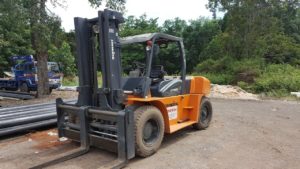Forklifts require expert handling to ensure the safety of both the operator and those working nearby. If your workplace contains forklifts, hopefully your forklift operators are already trained and certified as required by OSHA. If not, getting that training for them should absolutely be your first step in order to prevent injury.
Assuming your forklift operators are certified and ready to go, here are some other safety tips that can help contribute to a secure workplace when forklifts are involved. Encourage your forklift operators and other members of your workplace to follow these tips for the common good.
Establish and Stick to Forklift Paths
When possible, make sure everyone in your workplace knows the specific routes forklifts are going to be taking. Some businesses even choose to mark these paths to increase safety. Discourage workers from walking on the forklift paths, and if the forklift must detour from the path, warn the operator to proceed slowly and with extreme caution. Taking these steps will help you ensure that those on foot are kept safe from forklifts.
If people are walking and operating forklifts in the same area, reinforce to the forklift operators that they should always, always yield to foot traffic, no matter what. There are no exceptions to this rule.
Perform Daily Inspections
 Operator proficiency is only half the battle. You must also make sure that your forklift is in good working order each time you use it. You should inspect forklifts daily to make sure they are up to standard. Check the brakes, lights, horn, and steering mechanism to ensure they’ll all function properly when needed. Make sure the tires are full and the oil level is where it should be, and that there are no fluid leaks. The forks must be even, parallel, and not cracked or damaged—a problem with this part of the forklift could cause a load to be dropped, which could both damage property and cause injury to anyone who might be standing nearby.
Operator proficiency is only half the battle. You must also make sure that your forklift is in good working order each time you use it. You should inspect forklifts daily to make sure they are up to standard. Check the brakes, lights, horn, and steering mechanism to ensure they’ll all function properly when needed. Make sure the tires are full and the oil level is where it should be, and that there are no fluid leaks. The forks must be even, parallel, and not cracked or damaged—a problem with this part of the forklift could cause a load to be dropped, which could both damage property and cause injury to anyone who might be standing nearby.
Stabilize the Load
Every load a forklift moves needs to be well secured to ensure it doesn’t fall and cause damage and injury. The load should be tilted back while in motion, and the forks should be riding low, to increase stability. Those responsible for packing loads on pallets or skids should also receive training to ensure that they know how to prepare their load safely and securely. If the load hasn’t been properly prepared, the forklift operator should not attempt to move it.
Get your team the forklift safety training they need, as well as any other safety training courses.
